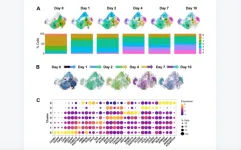New study led by Brown researchers sheds light on incidental findings in lung cancer screening
Standardizing reporting of abnormalities could minimize mortality, healthcare costs and unnecessary medical interventions
2023-05-09
(Press-News.org) PROVIDENCE, R.I. [Brown University]—When patients receive a low-dose computed tomography screen for lung cancer, doctors can see more than just the lungs. The screening test often picks up abnormalities or potentially “significant incidental findings” (SIFS) not associated with lung cancer. A new study led by Ilana Gareen, an associate professor of epidemiology at the Brown University School of Public Health, and published in JAMA Internal Medicine, highlights the need for proper reporting and management of these findings to reduce mortality, health care costs and unnecessary medical interventions.
“This study provides important insight into the types of significant incidental findings that can occur during low-dose computed tomography lung cancer screening,” Gareen said. “By better understanding these findings, we can improve how we classify and report them, which promises to improve patient care and improve the cost-effectiveness of lung cancer screening."
The study examined data from the National Lung Screening Trial, which involved over 53,000 participants aged between 55 and 74 years with a smoking history of 30 pack years—the equivalent of smoking one pack of cigarettes a day for 30 years—and who had smoked within the last 15 years. Participants were randomly assigned to undergo either low-dose computed tomography, known as LDCT, or chest X-rays. They were scheduled for three screening examinations: a baseline screen and two follow-up screens each one year apart. The current study focused on participants who received LDCT, which is now the accepted approach for lung cancer screening.
The results of the study showed that 33.8% of all LDCT participants had a significant incidental finding reported over the course of the trial, with 89.1% of those of sufficient clinical interest to to be reported to the referring provider.
“Lung cancer screening has been shown to reduce lung cancer mortality,” said Gareen, “but to enhance the cost-effectiveness of this intervention, patients and their medical providers must be aware of the high likelihood of SIF detection, and these SIFs must be appropriately reported and managed.”
Detecting SIFs has the potential to find extrapulmonary cancers early, which comprised 22.3% of certified deaths in the LDCT arm of the National Lung Screening Trial. Gareen and colleagues also found that more than 10% of all LDCT screens showed signs of emphysema and/or chronic obstructive pulmonary disease, which can be addressed with early intervention, such as smoking cessation.
The study highlights the importance of finding a balance between detecting serious conditions and avoiding unnecessary tests and procedures for significant incidental findings that turn out to be benign or present low risk to the patient, Gareen said.
Still, despite the high rate of significant incidental findings detected in LDCT screening, studies have shown that it is cost-effective compared to no screening at all. The researchers suggest that improving the classification and reporting of SIFs could better manage these findings and minimize unnecessary costs and medical care.
LDCT screening has been shown to reduce lung cancer deaths by up to 24%, but the researchers note that not many people are getting screened. The American College of Radiology introduced guidelines in 2015 to make it easier to report and manage results from screening and deal with significant abnormalities.
Contributors to this study include Roee Gutman, JoRean Sicks, Amal N. Trivedi, and Jerson Cochancela from Brown University; Caroline Chiles from the Wake Forest University School of Medicine; Ellen Underwood from Cigna; Efren Flores from Massachusetts General Hospital; Richard Hoffman from the Carver College of Medicine; and Tina Dinesh Tailor from the Duke University School of Medicine.
END
ELSE PRESS RELEASES FROM THIS DATE:
2023-05-09
“In summary, single-cell transcriptomic analysis has allowed us to identify the specific populations and the dynamic transition states during senescence initiation and progression.”
BUFFALO, NY- May 9, 2023 – A new research paper was published in Aging (listed by MEDLINE/PubMed as "Aging (Albany NY)" and "Aging-US" by Web of Science) Volume 15, Issue 8, entitled, “Single-cell transcriptomic analysis uncovers diverse and dynamic senescent cell populations.”
Senescence is a state of enduring growth arrest triggered by sublethal cell damage. Given that senescent cells actively ...
2023-05-09
Researchers at Baylor College of Medicine have linked specific variants or mutations of the gene myocardin-related transcription factor B (MRTFB) with a novel neurodevelopmental disorder. The team reports in the journal Genetics in Medicine that they were able to find variants in this gene in patients whose neurodevelopment disorders had previously gone undiagnosed. The research also revealed that the mutations disrupt the way the MRTFB protein controls other genes in the cell and this cascades to affect hundreds of other genes.
“We identified ...
2023-05-09
Many middle-aged and older women get mammograms every one to two years to screen for breast cancer, as recommended by their doctors. A study by researchers at Washington University School of Medicine in St. Louis indicates that previous mammograms hold underutilized data that could help identify women at high risk of breast cancer and even reveal which breast is likely to be affected.
When doctors read mammograms, they assess breast density along with signs of cancer, comparing a woman’s previous mammograms to her most recent one to look for worrisome changes. But some changes are difficult to ...
2023-05-09
(Boston)—COVID-19, the disease resulting from SARS-CoV-2 infection, is associated with highly variable clinical outcomes that range from asymptomatic disease to death. For those with milder infections, COVID-19 can produce respiratory infection symptoms (cough, congestion, fever) and sensory phenotypes such as headache and loss of sense of smell. In more severe cases, SARS-CoV-2 infection can affect nearly every organ and result in strokes from vascular occlusion, cardiovascular damage and acute renal failure. ...
2023-05-09
New Method Uses Engineered Bacteria and AI to Sense and Record Environmental Signals
Columbia synthetic biologists first to engineer bacterial swarm patterns to visibly record environment, use deep learning to decode patterns; applications could range from monitoring environmental pollution to building living materials
New York, NY—May 9, 2023—Researchers in Biomedical Engineering Professor Tal Danino’s lab were brainstorming several years ago about how they could engineer and apply naturally-pattern-forming bacteria. There are many bacteria species, such as Proteus mirabilis (P. mirabilis), that self-organize into defined patterns on solid surfaces that are visible ...
2023-05-09
Philadelphia, May 9, 2023 – The increase in obesity in lower-middle-income countries (LMIC) is largely thought to be affected by lifestyle transition away from traditional diets toward unhealthy Western dietary patterns that follow economic development. This study in the Journal of Nutrition Education and Behavior, published by Elsevier, collected data on eating and physical activity behaviors from families in two socioeconomically-different communities in Nairobi, Kenya. Researchers found that increasing prosperity is linked to unhealthy eating patterns in Kenyan preadolescents.
"Dietary ...
2023-05-09
The University of Ottawa’s Interdisciplinary Centre for Black Health survey reveals scope of coronavirus vaccine hesitancy in Black communities in relation to healthcare.
The health care system must play a significant role in combatting COVID-19 mistrust among Black individuals in Canada according to a new University of Ottawa study that found distrust in the healthcare network was so profound that educated individuals were hesitant to receive the vaccine.
Professor Jude Mary Cénat, Associate Professor in the School of Psychology at the Faculty of Social Sciences, is the Chair of the Interdisciplinary Centre ...
2023-05-09
CHICAGO, May 9, 2023 – Millions of people now regularly communicate with AI-based devices, such as smartphones, speakers, and cars. Studying these interactions can improve AI’s ability to understand human speech and determine how talking with technology impacts language.
In their talk, “Clear speech in the new digital era: Speaking and listening clearly to voice-AI systems,” Georgia Zellou and Michelle Cohn of the University of California, Davis will describe experiments to investigate how speech and comprehension change when humans communicate ...
2023-05-09
According to a new Johns Hopkins Medicine study, low pain self-efficacy can predict daily pre-surgery prescribed opioid use among patients seeking elective spine surgery. The study defined pain self-efficacy as the “beliefs held by people with chronic pain that they can carry out certain activities, even when experiencing pain.” Previous studies showed that lower pain self-efficacy is associated with higher pain intensity and greater pain interference in day-to-day life. However, the Johns Hopkins research team believes its study is among the first to investigate ...
2023-05-09
Vitamin D intake could reduce cancer mortality in the population by twelve percent - provided the vitamin is taken daily. This was the result of an evaluation of 14 studies of the highest quality conducted at the German Cancer Research Center with a total of almost 105,000 participants.
Vitamin D deficiency is widespread worldwide and is particularly common among cancer patients. Averaged over the year, the vitamin D blood levels of about 15 percent of German adults are below the threshold for a pronounced vitamin D deficiency*. In contrast, in a study of colorectal ...
LAST 30 PRESS RELEASES:
[Press-News.org] New study led by Brown researchers sheds light on incidental findings in lung cancer screening
Standardizing reporting of abnormalities could minimize mortality, healthcare costs and unnecessary medical interventions



